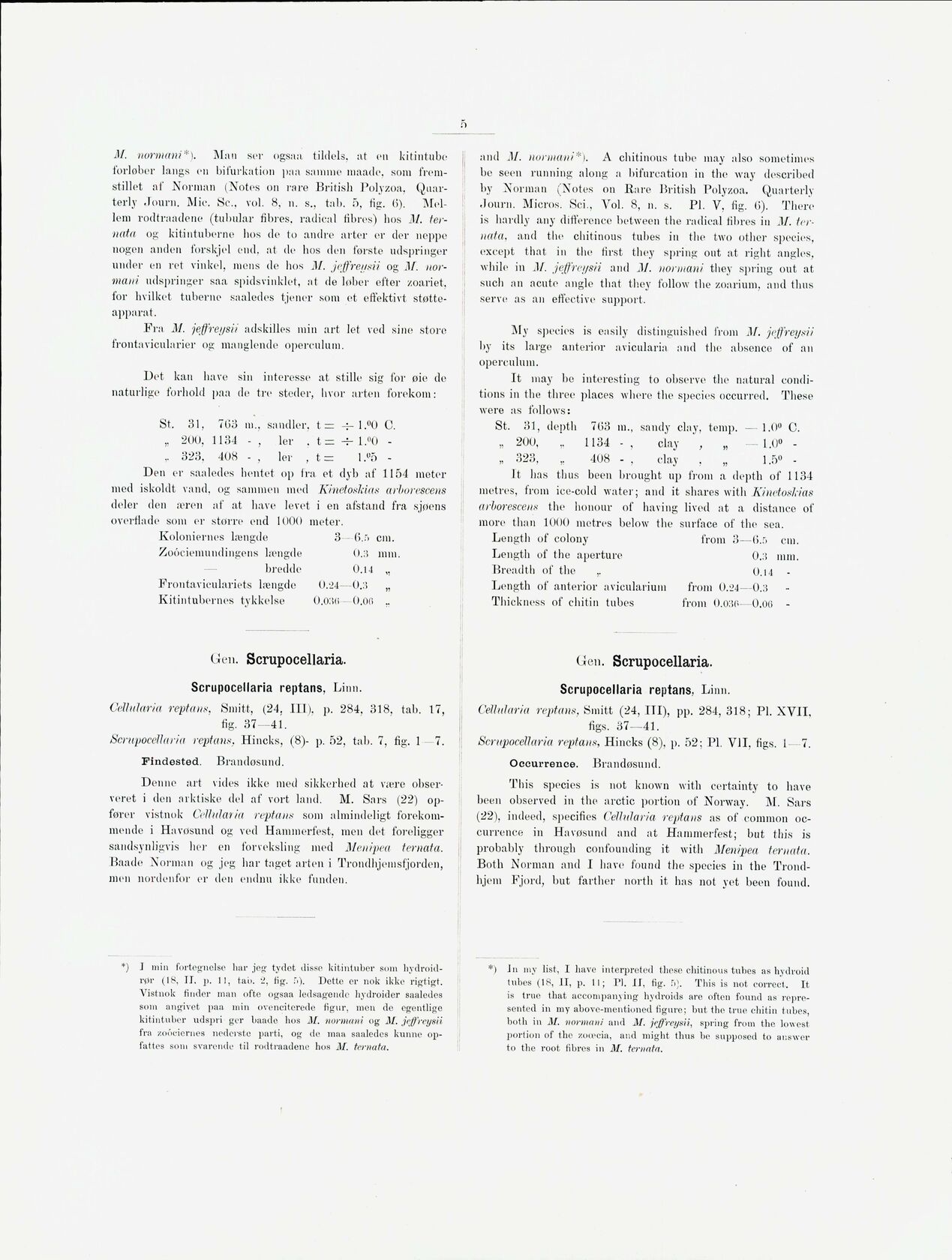
Full resolution (JPEG) - On this page / på denna sida - Sidor ...

<< prev. page << föreg. sida << >> nästa sida >> next page >>
Below is the raw OCR text
from the above scanned image.
Do you see an error? Proofread the page now!
Här nedan syns maskintolkade texten från faksimilbilden ovan.
Ser du något fel? Korrekturläs sidan nu!
This page has never been proofread. / Denna sida har aldrig korrekturlästs.
M. normani*). Man ser ogsaa, tildels, at en kitintubc
forløber langs en bifurkation paa samme maade, som
fremstillet af Norman (Notes 011 rare British Polyzoa,
Quarterly Journ. Mie. 8c., vol. 8, 11. s., tab. 5, fig. (i).
Mellem rodtraadene (tubular fibres, radical fibres) hos il/,
ternata og kitintuberne hos de to andre arter er der neppe
nogen anden forskjel end, al de hos den første udspringer
under en ret vinkel, mens de hos 71/. jeffrensii og il/,
nor-mani udspringer saa spidsvinklet, at de løber efter zoariet.
for hvilket tuberne saaledes tjener som et effektivt
støtteapparat.
Fra il/, jeffrei/sii adskilles min art let ved sine store
frontavicularier og manglende operculum.
Det kan have sin interesse at stille sig for øie de
naturlige forhold paa de tre steder, hvor arten forekom:
St. 31, 703 111., sandler, t= l.°U C.
„ 200, 1134 - , ler . t = -f- l.°0
-,. 323, 408 - , ler , t = l.°5 -
Den er saaledes hentet op fra et dyb af 1154 meter
med iskoldt vand. og sammen med Kinetoskias arborescens
deler den æren af at have levet i en afstand fra sjøens
overflade som er større end 1000 meter.
Koloniernes længde 3 6.r> cm.
Zoöciennindingens længde 0.3 111111.
bredde 0.14 ,,
Froiitaviculariets længde 0.24—O.:! „
Kitintubernes tykkelse O.OHü - O.Ofl ..
and M. normani*). A chitinous tube may also sometimes
be seen running along a bifurcation in the way described
by Norman (Notes 011 Rare British Polyzoa. Quarterly
.lourn. Micros. Sci., Vol. 8, 11. s. Pl. V, fig. (i). There
is hardly any difference between the radical fibres in M.
tornata, and the chitinous tubes in the two other species,
except that in the first they spring out at right angles,
while in M. jeffreysii and il/, normani they spring out at
such an acute angle that they follow the zoarium, and thus
serve as an effective support.
My species is easily distinguished from il/. jeffreysii
by its large anterior avicularia and the absence of an
operculum.
It may be interesting to observe the natural
conditions in the three places where the species occurred. These
were as follows:
St. 31, depth 703 111., sandy clay, temp. - 1.0« C.
„ 200, ,, 1134 - , clay , „ 1.0°
-„ 323, , 408 - , clay , „ 1.5° -
It lias thus been brought up from a depth of 1134
metres, from ice-cold water; and it shares with Kinetosldas
arborescens the honour of having lived at a distance of
more than 1000 metres below the surface of the sea.
Length of colony from 3—0.5 cm.
Length of the aperture 0.3 111111.
Breadth of the ,. 0.14 -
Length of anterior avicularium from 0.24—0.3
Thickness of cliitin tubes from 0.03f>- 0.0(i -
Gen. Scrupocellaria.
Scrupocellaria reptans, Liim.
Cell »lar ia reptans, Smitt, (24. Ill), p. 284, 318, tab. 17,
fig. 37 -41.
Scmpocellaria reptans. Hincks, (8)- p. 52, tab. 7, fig. 1 7.
Findested. Brandøsund.
Denne art vides ikke med sikkerhed at være
observeret i den arktiske del af vort land. M. Sars (22)
opfører vistnok Collularia reptans som almindeligt
forekommende i Havösund og ved Hammerfest, men det foreligger
sandsynligvis her en forveksling med Menipea ternata.
Baade Norman og jeg har taget arten i Trondhjemsfjorden,
men nordenfor er den endnu ikke funden.
Gen. Scrupocellaria.
Scrupocellaria reptans, Linn.
CelMaria reptans, Smitt (24, III), pp. 284, 318; Pl. XVII,
figs. 37—41.
Scrupocellaria reptans, Hincks (8), p. 52; Pl. VII. figs. 1 7.
Occurrence. Brandøsund.
This species is not known with certainty to have
been observed in the arctic portion of Norway. M. Sars
(22), indeed, specifies Celhtlaria reptans as of common
occurrence in Havösund and at Hammerfest; but this is
probably through confounding it with Menipea ternata.
Both Norman and I have found the species in the
Trondhjem Fjord, but farther north it has not vet been found.
*) .1 min fortegnelse liar jeg tydet disse kitintuber som
hydroid-rør (18, II. p. 11, tab. 2, fig. fi). Dette er nok ikke rigtigt.
Vistnok finder man ofte ogsaa ledsagende liydroider saaledes
som angivet paa min ovenciterede figur, men do egentlige
kitintuber udspri ger baade hos M. normani og M. jeffreysii
fra zoöcicrnes nederste parti, og de maa saaledes kunne
opfattes som svarende til rodtraadene hos M. ternata.
*) In my list, I have interpreted these chitinous tubes as hydroid
tubes (18, II, p. 11; PI. II, fig. ,r>). This is not, correct,. It
is true that accompanying hydroids are often found as
represented in my above-mentioned figure; but the true chitin tubes,
both in M. normani and M. jeffreysii, spring from the lowest
portion of the zoieeia, and might thus be supposed to answer
to the root fibres in M. ternata.
<< prev. page << föreg. sida << >> nästa sida >> next page >>